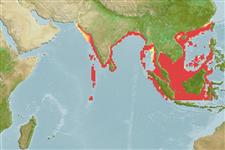Common names from other countries
Environment: milieu / climate zone / depth range / distribution range
Sinh thái học
; Thuộc về nước lợ; Mức độ sâu 0 - 200 m (Ref. 356). Tropical, preferred 28°C (Ref. 107945); 27°N - 6°S, 65°E - 121°E
Indo-West Pacific: from Pakistan to Taiwan and Indonesia.
Length at first maturity / Bộ gần gũi / Khối lượng (Trọng lượng) / Age
Maturity: Lm ? range ? - ? cm Max length : 19.0 cm TL con đực/không giới tính; (Ref. 356); 21.2 cm TL (female)
Maximum TL: 16.3 cm (male); 21.2 cm (female). Maximum carapace length: 3.1 cm (male); 3.3 cm (female) (Ref. 8). Vulnerability for synonym Fenneropenaeus penicillatus is 50. Juveniles inhabit mangrove inlets (Refs. 114627, 121464), intertidal mud flats and far inshore waters (Ref. 121464). In general, the majority of penaeids are omnivorous or detritus feeders (Ref. 105082).
Life cycle and mating behavior
Chín muồi sinh dục | Sự tái sinh sản | Đẻ trứng | Các trứng | Sự sinh sản | Ấu trùng
Members of the order Decapoda are mostly gonochoric. Mating behavior: Precopulatory courtship ritual is common (through olfactory and tactile cues); usually indirect sperm transfer.
SAUP Database. 2006. (Ref. 356)
IUCN Red List Status (Ref. 130435)
CITES status (Ref. 108899)
Not Evaluated
Not Evaluated
Human uses
Các nghề cá: Tính thương mại
FAO - Nuôi trồng thủy sản: Sản xuất; Các nghề cá: landings | FishSource | Biển chung quanh ta
Các công cụ
Các nguồn internet
Estimates based on models
Preferred temperature
(Ref.
115969): 20.4 - 26.1, mean 23.6 (based on 156 cells).
Vulnerability
Low vulnerability (10 of 100).
